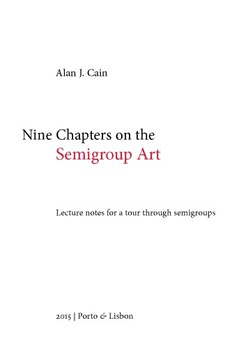
Nine Chapters on the Semigroup Art PDF
Preview Nine Chapters on the Semigroup Art
Alan J. Cain Nine Chapters on the Semigroup Art Lecture notes for a tour through semigroups 2015 | Porto & Lisbon ©2012–15AlanJ.Cain ([email protected]) version0.62.2(2015/11/21) To download the most recent version, and files suitable for colour or greyscale printing, or for viewing on tablets and ebookreaders,visit www-groups.mcs.st-and.ac.uk/~alanc/pub/c_semigroups/ ThisworkislicensedundertheCreativeCommonsAttribu- tion–Non-Commercial–NoDerivs4.0InternationalLicence. Toviewacopyofthislicence,visit creativecommons.org/licenses/by-nc-nd/4.0/ orwriteto CreativeCommons 444CastroStreet,Suite916 MountainView California94041 UnitedStates Contents Preface vi Prerequisites ◆ Acknowledgements Chapter1|Elementarysemigrouptheory 1 Basicconceptsandexamples ◆ Generatorsandsubsemi- groups ◆ Binaryrelations ◆ Ordersandlattices ◆ Homo- morphisms ◆ Congruencesandquotients ◆ Generating equivalences and congruences ◆ Subdirect products ◆ Actions ◆ Cayleygraphs ◆ Exercises ◆ Notes Chapter2|Freesemigroups&presentations 44 Alphabetsandwords ◆ Universalproperty ◆ Propertiesof freesemigroups ◆ Semigrouppresentations ◆ Exercises ◆ Notes Chapter3|Structureofsemigroups 66 Green’s relations ◆ Simple and 0-simple semigroups ◆ D-classstructure◆InversesandD-classes◆Schützenberger groups ◆ Exercises ◆ Notes Chapter4|Regularsemigroups 89 Completely0-simplesemigroups ◆ Idealsandcompletely 0-simplesemigroups ◆ Completelysimplesemigroups ◆ Completelyregularsemigroups ◆ Leftandrightgroups ◆ Homomorphisms ◆ Exercises ◆ Notes • iii Chapter5|Inversesemigroups 114 Equivalentcharacterizations ◆ Vagner–Prestontheorem ◆ Thenaturalpartialorder ◆ Cliffordsemigroups ◆ Free inversesemigroups ◆ Exercises ◆ Notes Chapter6|Commutativesemigroups 150 Cancellative commutative semigroups ◆ Archimedean decomposition ◆ Freecommutativesemigroups ◆ Rédei’s theorem ◆ Exercises ◆ Notes Chapter7|Finitesemigroups 171 Green’srelationsandideals ◆ Semidirectandwreathprod- ucts ◆ Division ◆ Krohn–Rhodesdecompositiontheorem ◆ Exercises ◆ Notes Chapter8|Varieties&pseudovarieties 195 Varieties◆Pseudovarieties◆Pseudovarietiesofsemigroups andmonoids◆Freeobjectsforpseudovarieties◆Projective limits ◆ Pro-Vsemigroups ◆ Pseudoidentities ◆ Semidirect productsofpseudovarieties ◆ Exercises ◆ Notes Chapter9|Automata&finitesemigroups 230 Finiteautomataandrationallanguages ◆ Syntacticsem- igroups and monoids ◆ Eilenberg correspondence ◆ Schützenberger’stheorem ◆ Exercises ◆ Notes Solutionstoexercises 264 Bibliography 326 Index 332 • iv List of Tables Table8.1 Varietiesofsemigroups 204 Table8.2 Varietiesofmonoids 204 Table8.3 Varietiesofsemigroupswithaunaryoperation−1 205 Table8.4 S-pseudovarietiesofsemigroups 222 Table8.5 M-pseudovarietiesofmonoids 223 Table9.3 Varietiesofrational∗-languages 251 Table9.4 Varietiesofrational+-languages 252 • • v Preface ‘Aprefaceisfrequentlyasuperior compositiontotheworkitself…’ —IsaacD’Israeli, ‘Prefaces’.In:CuriositiesofLiterature. • Thiscourse is a tour through selected areasof semi- grouptheory.Thereareessentiallythreeparts: ◆ Chapters1–3studygeneralsemigroups,includingpresentationsfor semigroupsandbasicstructuretheory. ◆ Chapters4–6examinespecialclasses:namelyregular,inverse,and commutativesemigroups. ◆ Chapters7–9studyfinitesemigroups,theirclassificationusingpseu- dovarieties,andconnectionswiththetheoryofautomataandregular languages. Thecourseisbroadratherthandeep.Itisnot intendedtobecomprehens- ive:itdoesnottrytostudy(forinstance)structuretheoryasdeeplyas Howie,FundamentalsofSemigroupTheory,pseudovarietiesasdeeplyas Almeida,FiniteSemigroupsandUniversalAlgebra,orlanguagesasdeeply asPin,VarietiesofFormalLanguages;rather,itsampleshighlightsfrom eacharea.Itshouldbeemphasizedthatthereisverylittlethatisoriginal in this course. It is heavily based on the treatments in these and other standardtextbooks,asthebibliographicnotesineachchaptermakeclear. The main novelty is in the selection and arrangement of material, the slightlyslowerpace,andthegeneralpolicyofavoidingleavingproofsto thereaderwhenthecorrespondingresultsarerequiredforlaterproofs. Preface • vi FigureP.1showsthedependenciesbetweenthechapters.Attheend of each chapter, there are a number of exercises, intended to reinforce concepts introduced in the chapter, and also to explore some related topicsthatarenotcoveredinthemaintext.Themostimportantexercises are marked with a star ✴ . Solutions are supplied for all exercises. At theendofeachchapterarebibliographicnotes,whichgivesourcesand suggestionsforfurtherreading. Warningsagainstpotentialmisunderstandingsaremarked(likethis) witha‘dangerousbend’symbol,asperBourbakiorKnuth. Importantobservationsthatarenotpotentialmisunderstandingsperse aremarkedwithan‘exclamation’symbol(likethis). Thiscoursewasoriginallydeliveredtomaster’sstudentsattheUni- versitiesofPortoandSantiagodeCompostella.Thecoursewascovered during 56 hours of classes, which included lectures and discussions of theexercises.Revisionshaveincreasedthelengthofthenotes,andabout 70hoursofclasstimewouldnowberequiredtocoverthemfully. Thesenoteswereheavilyrevisedin2013–15.Mostofthemaintextis nowstable,butChapter8willbefurtherrevised,andfurtherexercises willbeadded.Theauthorwelcomesanycorrections,observations,or constructivecriticisms;pleasesendthemtotheemailaddressonthe copyrightpage.Atpresent,theindexislimitedtonamesand‘named results’only. Prerequisites Therearefewformalprerequisites:generalmathematical maturityisthemainone.Anunderstandingofthemostbasicconcepts fromelementarygrouptheoryisassumed,suchasthedefinitionofgroups, cosets,andfactorgroups.Someknowledgeoflinearalgebrawillhelpwith understanding certain examples, but is not vital. For Chapters 1 and 5, knowledgeofthebasicdefinitionsofgraphtheoryisassumed.Somebasic topologyisnecessarytoappreciatepartofChapter8fully(althoughmost Prerequisites • vii ofthechaptercanbeunderstoodwithoutit,andtherelevantsectionscan simplybeskipped),andsomebackgroundinuniversalalgebraisuseful, butnotessential.ForChapter9,someexperiencewithformallanguage theoryandautomataisuseful,butagainnotessential. Acknowledgements AttilaEgri-Nagymadevaluablesuggestionsandindicated variouserrors.SomeexercisesweresuggestedbyVictorMaltcev.Nick Ham pointed out a typo. Many improvements are due to the students whotookthefirstversionofthiscourse:MiguelCouto,XabierGarcía, andJorgeSoares.Theimperfectionsthatremainaremyresponsibility. Thetitlealludesto九章算術,NineChaptersontheMathematicalArt. A. J. C. • Acknowledgements • viii Chapter 1 Elementary semigroup theory Chapter 2 Free semigroups & presentations Chapter 3 Structure of semigroups Chapter 4 Regular semigroups Chapter 5 Inverse semigroups Chapter 6 Commutative semigroups Chapter 7 Finite semigroups Chapter 8 Varieties & pseudovarieties Chapter 9 Automata & finite semigroups FIGUREP.1 Chartofthedependenciesbetweenthechapters.Dottedarrowsindicatethat thedependencyisonlyintheexercises,notinthemaintext. Acknowledgements • ix 1 Elementary semigroup theory ‘Iusetheword“elementary”inthesense inwhichprofessionalmathematiciansuseit…’ —G.H.Hardy, AMathematician’sApology,§21. •Abinaryoperation∘onaset𝑆isamap∘ ∶ 𝑆×𝑆 → 𝑆. This operation is associative if 𝑥 ∘ (𝑦 ∘ 𝑧) = (𝑥 ∘ 𝑦) ∘ 𝑧 for all elements 𝑥,𝑦,𝑧 ∈ 𝑆.Asemigroupisanon-emptysetequippedwithanassociative binaryoperation. Semigroups are therefore one of the most basic types of algebraic structure.Wecouldweakenthedefinitionfurtherbyremovingtheas- sociativityconditionandrequiringonlyabinaryoperationonaset.A structurethatsatisfiesthisweakerconditioniscalledamagmaorgroup- oid.(These‘groupoids’aredifferentfromthecategory-theoreticnotionof groupoid.) Ontheotherhand,wecanstrengthenthedefinitionbyrequiringan identityandinverses.Structuressatisfyingthisstrongerconditionareof coursegroups.However,therearemanymoresemigroupsthangroups. Forinstance,thereare5essentiallydifferentgroupswith8elements(the cyclicgroup𝐶 ,thedirectproducts𝐶 ×𝐶 and𝐶 ×𝐶 ×𝐶 ,thedihed- 8 4 2 2 2 2 ralgroup𝐷 ,andthequaterniongroup𝑄 ),butthereare3684030417 4 8 different(non-isomorphic)semigroupswith8elements. Elementarysemigrouptheory • 1
